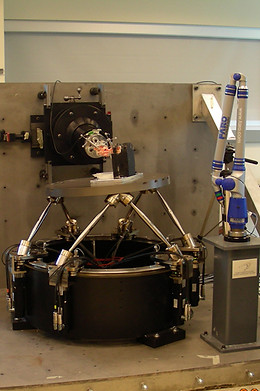
University of Calgary

Shon Darcy PhD (Candidate), Craig Sutherland (Surgeon).
Mikrolar Provides A Testing Platform for Joint Research
The University of Calgary has long been committed to cutting edge research in a variety of areas. To this end, the Calgary Centre for Innovative Technology (CCIT) was built to provide a world class interdisciplinary research facility committed to producing significant advances in knowledge and finding novel solutions to strategic challenges.
One area of focus for CCIT is Biomedical Engineering. Researchers are trying to understand the factors that contribute to the development of osteoarthritis following ligament reconstructive surgery. In order to collect the required data, they needed to be able to reproduce the loading and range of motion seen in living tissue in a laboratory setting.
The University of Calgary found that the Mikrolar R2000 Rotopod (legacy of the R3000) was able to provide all the required motion while maintaining the high degree of precision necessary to obtain accurate data. Read below for a paper on the topic.
A Robotic Testing System Which Reproduces Real Motion
"The knee joint is a sophisticated biological mechanism involved in locomotion at the lower extremity. Its function is often sustained for a lifetime, at a rate of over 1 million cycles per year, without signs of damage. Despite is apparently simple motion during gait, the knee actually features complex 3D motion that stems from the biomechanical interdependence and balance of its component tissues. Following joint injury, such balance is upset and is difficult to restore with existing clinical treatments. The knee joint is also the most commonly injured joint in the body. In order to successfully treat injuries to the knee, the biomechanical responses of ligaments is necessary; from the clinical perspective in order to gain insight into injury mechanisms, develop prevention strategies and evaluate treatment options that optimize healing; from a basic science perspective, in order to understand the load environment of the tissues for the advancement of tissue engineering; and from and engineering perspective to develop feedback control mechanisms for assistive technology (e.g. functional electrical stimulation) to assist and mobilize patients with spinal cord injuries.

R2000 Rotopod & Dr. Shrive.

Mikrolar's R2000.
Making accurate estimations of forces that occur in a living system's locomotive apparatus remains one of the most significant challenges in orthopedic biomechanics, and the knee joint is no exception. In fact, direct measurement of in vivo forces in the knee has not been determined experimentally until last year at the University of Calgary. Existing strain transducers require some form of contact with the subject tissue in order to convert the mechanical energy stored in its deformation into a measurable signal, rendering them impractical. Thus, part of the challenge lies on identifying a non-invasive and non-destructive methodology to obtain the data of interest. Robotics has been used for many industrial applications such as automobile manufacturing, flight simulation, and spot welding. A newly developed experimental robotic manipulator, a parallel robot, boasts higher accuracy and rigidity due to its parallel design, small work volume and the proximity of the robot's global and end effector coordinate systems. These design optimizations have led to the use of this robot in one of the most advanced biomechanical applications to date, reproducing in vivo motion which is recorded in response to muscle actions. This is a powerful new methodology to understand mechanical environment of the normal and injured knee, it will soon be able to assess the effect of multiple injuries to joint structures immediately following injury."
Interview at University of Calgary.


Nigel Shrive Killam Research Chair FICE, P.Eng, C.Eng, Shon Darcy & Josh Rosvold PhD.

Shon Darcy With U of Calgary's R2000.


